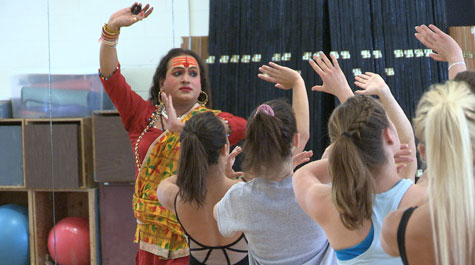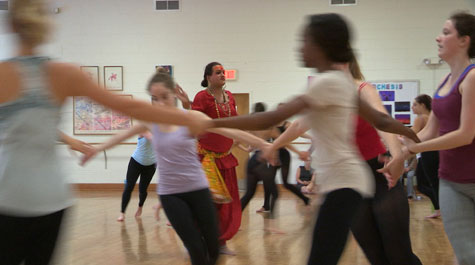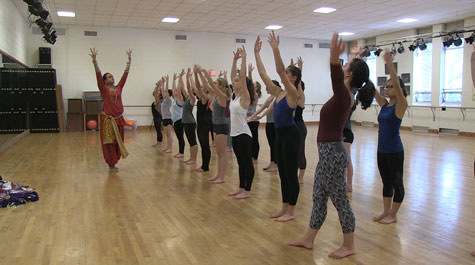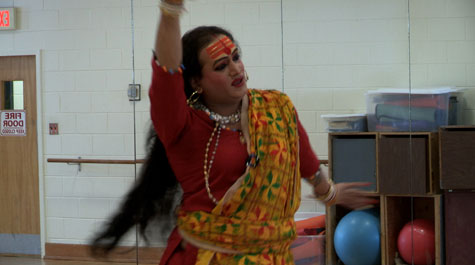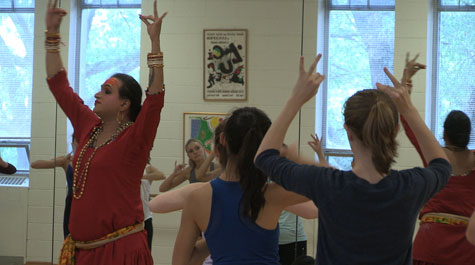COLL 300 visitor teaches students Indian dance
Laxmi Narayan Tripathi explained that the hand movement has to be perfect, then demonstrated it while counting to eight. William & Mary dance students repeated it identically and in sync.
“Where your hand, goes your eyes,” she said. “That is your soul.”
This was the scene at a dance class that was part lesson and part rehearsal during Tripathi’s visit to campus Sept. 9-15.
Tripathi is a hijra transgender activist from India who is an author, dancer and actress. She is an advocate for the rights of the hijra, which is a very old community in India that identifies its members as neither male nor female. Tripathi was the plaintiff in litigation winning legal recognition for a third gender from the Indian Supreme Court in 2014, and she has worked to broaden gender definitions at the United Nations and other global forums on HIV and AIDS.
{{youtube:medium:right|ZiZdUDPCv4s, In the dance studio}}
Tripathi gave the fall semester’s first COLL 300 lecture at W&M on Sept. 13. Established in 2015, the College Curriculum is a set of specially designed courses that connect and integrate knowledge from the major and electives, extending across four years.
The COLL 300 is typically taken in a student’s third year and emphasizes experiences and knowledge of the larger world. This fall’s COLL 300 theme is IN/EXclusion and planned visitors are practitioners Ifarinwale Ogundiran and Bamigboye Adewale Adebukola Oct. 9-13, presenting an introduction to traditional Yoruba Ifa religion in Nigeria and Native American expert on tribal law, and federal Indian policy Sarah Deer, who has worked for 20 years to end violence against women focusing specifically on Native women and communities, Nov. 14-17.
Part of Tripathi’s COLL 300 remarks and performance included a dance, which W&M students participated in. Tripathi ran her own dance academy a decade ago, and she had a short turnaround time of two rehearsals to teach and perfect the Indian dance with the students.
They worked on it during Lecturer of Dance Lauren Morris’ modern dance class on Sept. 12 in the Adair Hall Dance Studio and again that evening at Phi Beta Kappa Memorial Hall, performing it there the next night.
Tuesday’s midday session was a whirlwind of activity, with Tripathi starting and stopping the music frequently to demonstrate again, tweak a movement here and there or reiterate a subtlety in the movements.
She called the students “fast learners” and was thrilled with how quickly they picked up the choreography.
“Yeah, they did it,” she said. “And I’m very proud that they did it so beautifully.”
Anxious to get started, Tripathi started putting students into lines by height and asking their names before the class had officially started. She flew around the room, often taking a place in line with them as they learned the movements she repeatedly demonstrated while explaining the emotions the movements represent.
“Enjoy,” she kept saying. “Smile.”
And smile she did, swishing her arms forward and back while emphasizing the intricate footwork.
“Your hands should flow,” she said. “Don’t let it catch (at the hip). Let it fly.”
Students let them fly, careful to keep their fingers placed as she had.
“Beautiful,” Tripathi said. “I love it.”
A brief lull gave a chance to check on what students would wear to perform, which sent two faculty members scurrying off to a costume closet to see what they could find to supplement the chosen black leotards and leggings.
“I’m bad; I’m not giving you rest,” Tripathi said, showing the charming humor that is her trademark. “But tomorrow we have to perform.”
She encouraged questions, and students asked for a few clarifications as they sought to learn the dance quickly. She went to them individually to show them the answers, frequently checking and rechecking that everybody understood what was being taught.
A busy schedule for the week had Tripathi visiting other classes and groups for meals to talk about her experiences and work. She took a brief break to sit for only a moment after the dance class before she was whisked off to lunch with students.















